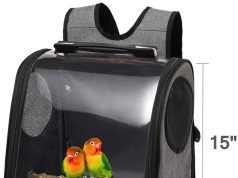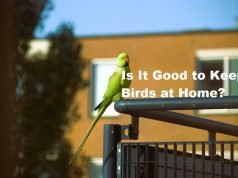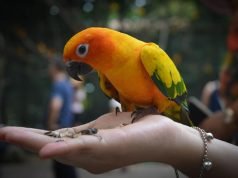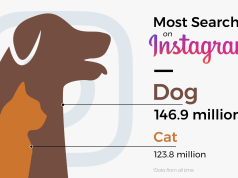Creating a Haven for Feathered Friends: A Guide to Building a Bird-Friendly Home
Tips and strategies for creating a bird-friendly environment at home to enhance the well-being and happiness of pet birds.
Table of Contents
Introduction to Creating a Bird-Friendly Environment at Home
Creating a bird-friendly environment at home goes beyond just providing the necessities for pet birds. Tips for creating a bird-friendly environment
- Place feeders less than 3 feet from the house to prevent window strikes
- Make windows visible to birds with screens, decals, or dirty glass
- Keep cats indoors or consider a “catio” enclosure to protect birds
- Grow native plants to support bird conservation
- Encourage bird-friendly practices in the community through social influence
- Practice benign neglect in yardwork to provide food and shelter for birds
- Clean bird feeders and baths every two weeks to prevent disease outbreaks. One key aspect of this is to offer a variety of enrichment activities that cater to their physical and mental stimulation, such as providing different toys and opportunities for foraging. By incorporating these elements into their habitat, you can enhance their quality of life and overall health.
In addition to physical enrichment, setting up a bird-friendly habitat also involves creating a safe and secure space for your feathered friends. This can include measures like using screens, decals, or dirty glass on windows to prevent bird strikes. Furthermore, incorporating native plants in your garden not only supports bird conservation efforts but also provides a familiar and natural environment for birds to thrive in. These small adjustments can make a significant difference in attracting and supporting bird species in your home environment.
Importance of Creating a Bird-Friendly Environment
Creating a bird-friendly environment goes beyond just meeting the basic needs of pet birds; it plays a crucial role in their overall well-being and quality of life. By offering a safe and stimulating habitat, you can significantly reduce stress and minimize behavioural issues commonly seen in pet birds. For example, incorporating a variety of enrichment activities like different types of toys and foraging opportunities can keep your feathered friends engaged and mentally stimulated, which in turn promotes their overall health and happiness.
Moreover, a thoughtfully designed bird-friendly habitat not only benefits the individual pet birds but also contributes to larger conservation efforts. By implementing bird-friendly practices in your home, such as providing clean water sources, sheltered areas, and native plants for food sources, you are indirectly supporting the preservation of avian species and their natural habitats. These small acts of creating a bird-friendly environment in your own backyard can have a ripple effect on the broader ecosystem, encouraging biodiversity and sustainability in your local community. Additionally, by understanding the specific needs of different bird species and catering to those requirements in your habitat setup, you are actively participating in the protection and conservation of our feathered friends.
 Tips for Setting Up a Bird-Friendly Habitat
Tips for Setting Up a Bird-Friendly Habitat
Creating a bird-friendly habitat involves several key elements to ensure the well-being and safety of our feathered friends. In addition to installing bird baths for clean water access and incorporating a variety of birdhouses, it’s essential to pay attention to the types of plants in the garden. Choosing native plants that produce berries, seeds, and nectar can provide natural food sources for birds while also attracting a diverse range of species. For example, planting a flowering shrub like a butterfly bush can not only offer nectar for hummingbirds but also provide a beautiful focal point in the garden.
Moreover, supplementing the habitat with bird feeders containing different types of seeds can further entice birds to visit and linger in the area. For instance, setting up a thistle feeder can attract finches, while a suet feeder may appeal to woodpeckers and nuthatches. By diversifying the food offerings, you can cater to the varied dietary needs of different bird species, enhancing the overall bird-welcoming environment in your backyard. Additionally, incorporating bird-friendly practices like avoiding the use of pesticides and creating a pesticide-free zone can help protect birds from harmful chemicals and promote a healthier ecosystem in your garden. These small adjustments can have a significant impact on the well-being and longevity of the bird population in your area.
 Enrichment Activities for Pet Birds
Enrichment Activities for Pet Birds
Enrichment activities are essential for keeping pet birds mentally stimulated and physically active. In addition to rotating different types of bird toys, consider incorporating interactive toys that encourage play and exploration. For example, puzzle toys that dispense treats when solved can be a fun and engaging way to keep your bird entertained while also providing mental enrichment. By offering a variety of toys that cater to different behaviours, such as shredding, climbing, or foraging, you can prevent boredom and encourage natural instincts in your feathered friend.
Responsible Practices for Buying and Selling Pet Birds
When considering buying or adopting a pet bird, it is crucial to prioritize responsible practices to ensure the well-being of the birds. One essential practice is to thoroughly research and select reputable bird breeders or sellers who prioritize the welfare of their birds. For instance, establishments accredited by avian organizations like the American Federation of Aviculture (AFA) or the Avicultural Society of America (ASA) often adhere to high standards of care and breeding practices, promoting the health and happiness of the birds they sell.
Moreover, before bringing a pet bird home, it is important to verify that the bird has been properly weaned and socialized. Birds that have been appropriately weaned are more likely to adapt well to their new environment and have a reduced risk of health issues related to improper care during the weaning process. Socialization is also crucial for pet birds to develop trust with humans and other birds, leading to a more fulfilling and interactive relationship between the bird and its owner. Therefore, ensuring that these aspects are addressed before acquiring a pet bird is fundamental to establishing a harmonious bond and conducive living environment.
In addition to these considerations, it is essential to contemplate the long-term commitment involved in caring for a pet bird. Different bird species have varying lifespans, dietary requirements, social needs, and levels of interaction with humans. For example, larger parrot species like macaws and cockatoos can live for several decades, requiring a significant commitment of time, effort, and resources throughout their lives. Understanding the specific needs of the bird species you are interested in and acknowledging the responsibilities associated with their care is paramount in providing a loving and stable home for a pet bird.
 Attracting Birds to Your Garden
Attracting Birds to Your Garden
Attracting birds to your garden can be a rewarding experience for both you and the feathered visitors. One effective way to entice a variety of bird species is by strategically placing a diverse selection of bird feeders around your outdoor space. For example, setting up a feeder with sunflower seeds can attract cardinals, while a thistle feeder may draw in finches and sparrows. By offering different types of seeds and food, you can cater to the dietary preferences of various bird species, creating a welcoming environment for them to frequent.
In addition to providing food, incorporating a water feature into your garden can significantly enhance its attractiveness to birds. Installing a birdbath or a small pond not only offers birds a place to drink but also provides them with a spot to bathe and cool off. This simple addition can be a magnet for different bird species, especially during hot summer days when water sources may be scarce. Watching birds splash around and interact at a birdbath can be a delightful and peaceful way to connect with nature right in your backyard.
Furthermore, planting native trees and shrubs that yield berries and fruits can serve as a natural buffet for birds. Species like elderberry, serviceberry, and dogwood produce fruits that are not only visually appealing but also nutritious for birds. These plants can attract a wide array of avian visitors, from songbirds that feed on berries to woodpeckers that enjoy fruits. By incorporating these native vegetation options into your garden, you can create a sustainable food source that supports the local bird population and adds beauty to your outdoor space.
Supporting Bird Conservation Efforts
Supporting bird conservation efforts is crucial to protecting avian species and their habitats. One way to actively engage in conservation is by participating in bird counts and surveys. By contributing data to conservation organizations through these activities, individuals can help researchers better understand bird populations, migration patterns, and habitat needs. For example, joining the annual Great Backyard Bird Count organized by the Cornell Lab of Ornithology and the National Audubon Society allows bird enthusiasts to document the birds they see in their area, providing valuable information for scientific research and conservation initiatives.
Another effective way to support bird conservation is by getting involved with local birdwatching groups or clubs. These community-based organizations offer opportunities to connect with fellow bird enthusiasts, share knowledge about local bird species, and collaborate on conservation projects. For instance, participating in bird banding activities organized by local bird clubs can help monitor bird populations, track individual birds, and contribute to important research on bird behaviour and ecology. By engaging with like-minded individuals, bird lovers can work together to promote conservation efforts in their communities and beyond.
Additionally, reducing light pollution in residential areas can have a significant impact on protecting nocturnal bird species and their habitats. Artificial light at night can disorient migrating birds, interfere with their natural behaviours, and disrupt their breeding cycles. By using motion sensor lights, installing shielded fixtures, or simply turning off unnecessary outdoor lights, individuals can create a safer environment for birds that rely on the cover of darkness. Taking steps to minimize light pollution not only benefits nocturnal birds but also contributes to the overall health of ecosystems and wildlife populations.
You May Like: Mastering Bird Training: Unlocking the Secrets to…
Conclusion: Enhancing Your Bird-Friendly Environment
Creating a bird-friendly environment at home is a rewarding experience that not only benefits your pet birds but also contributes to the well-being of local bird populations. By incorporating various elements like bird baths, birdhouses, and native plants in your garden, you can attract a diverse range of bird species. For example, installing a birdbath can provide a vital water source for birds to drink and bathe, while different types of birdhouses can cater to the specific needs of various bird species, such as cavity nesters like Bluebirds or Chickadees.
Furthermore, supporting bird conservation efforts through active participation in bird counts, surveys, or local birdwatching clubs can enhance your understanding of avian species and their conservation needs. For instance, joining a birdwatching group can provide valuable insights into the migratory patterns of different bird species in your area, allowing you to tailor your bird-friendly practices to better support them. Remember, every step you take towards creating a bird-friendly environment, no matter how small, can have a positive impact on the health and well-being of birds in your care as well as the broader avian community.


 Tips for Setting Up a Bird-Friendly Habitat
Tips for Setting Up a Bird-Friendly Habitat Enrichment Activities for Pet Birds
Enrichment Activities for Pet Birds Attracting Birds to Your Garden
Attracting Birds to Your Garden








